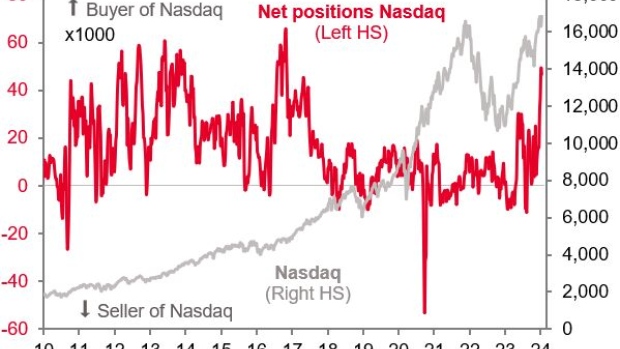Jan 18, 2024
Big-Tech Rally Heats Up, Breeding Overcrowding Fears
, Bloomberg News

(Bloomberg) -- After being caught flat-footed early last year, fund managers have gone all-in on technology stocks — so much so that it’s sparking warnings that the Nasdaq 100 Index is looking ever more vulnerable to investor pullbacks.
There are ample signs that investor euphoria around Big Tech is running high amid bets that the Federal Reserve will deliver a rapid series of interest-rate cuts in the coming months.
Hedge funds hold the highest level of net-long Nasdaq 100 futures in nearly seven years, according to Societe Generale’s weighted analysis of data on the Nasdaq 100 Index futures and e-mini contracts provided by the Commodities Futures Trading Commission. Meanwhile, a global fund manager survey from Bank of America Corp. this month showed the most crowded trade is being long the so-called Magnificent Seven stocks and other tech-related growth shares as a way to play the prospect of Fed easing.
The positioning looked good on Thursday, with strength in tech shares pushing the Nasdaq 100 up as much as 1.4%. But it also raises the stakes for the coming weeks as investors parse quarterly earnings for a fresh reading on the sector’s growth prospects.
“Investors feel obliged to have a very strong weighting on the Nasdaq 100,” said Arthur van Slooten, a global asset allocation strategist at Societe Generale. “Obviously the performance is good. But the other reason is if they are not sufficiently weighted on the Nasdaq 100, they will probably underperform their equity benchmark.”
The heavy exposure also means “the potential downside is bigger,” he said.
January Outperformance
Coming off a 54% surge in 2023, its best performance since the dot-com boom of the late 1990s, the Nasdaq 100 is outpacing other major US benchmarks in January with a slight gain.
It lost some steam at the start of the month as solid economic data and remarks from Fed officials led traders to trim wagers on a rate cut as soon as this quarter. The Cboe NDX Volatility Index — a measure of expected turbulence in the tech-heavy benchmark — is around its highest since November, a sign of demand for options to hedge against declines in the underlying gauge.
At Vontobel Swiss Financial Advisors, Pascal Koeppel is keeping his sector holding neutral, on the view that the rate of growth of megacap tech firms has peaked.
“Investors are really overexposed to tech,” said the firm’s chief investment officer. “Can tech companies repeat the growth that they had in the last 10 years into the next 10 years? I don’t know the answer, but the probability is lower that they will have this abnormally high growth.”
Even so, UBS Group AG expects artificial intelligence — a major driver behind last year’s rally — to serve as a tailwind to stocks for years to come. The firm sees AI industry revenue growing soaring to some $420 billion by 2027, to some $420 billion, from $28 billion in 2022.
For Ayako Yoshioka, senior portfolio manager at Wealth Enhancement Group, it’s still a bigger risk to be underweight the sector than overweight because the growing array of ways that AI can be used will further propel companies like Nvidia Corp.
“Tech definitely is a little bit overvalued now,” said Yoshioka, who oversees around $700 million and has been overweight tech for at least the last five years. Still “we remain overweight. We’re going to take some pain in the near term, but I think that’s going to be offset.”
©2024 Bloomberg L.P.





